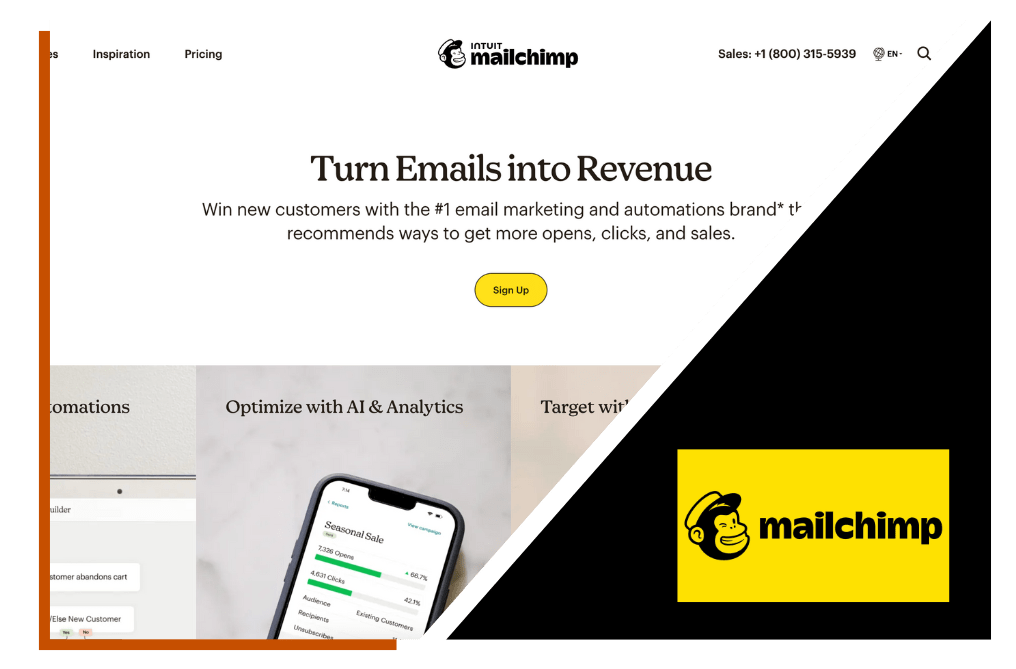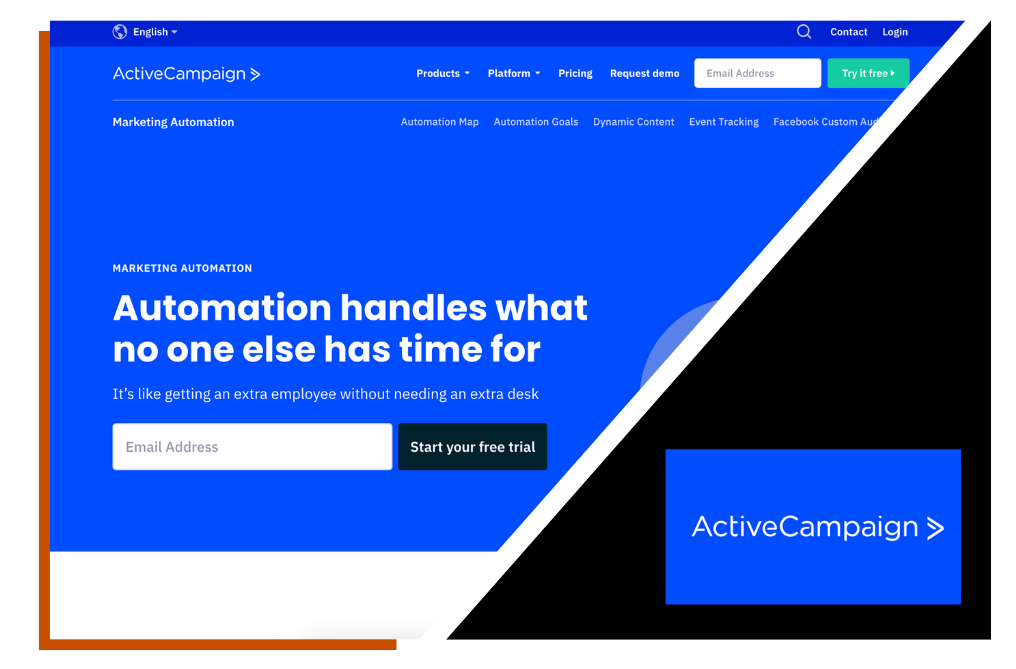What is Digital Engagement?
4 Best Email Marketing Tools
- Content Strategy
- Marketing
- Technology
- and 1 more...

"Email marketing" sounds a bit old school considering it has been in widespread use for nearly 40 years. But when it comes to reaching customers, email marketing is still one of the most effective tools aspiring companies utilize.
Considering its importance, choosing an email marketing tool that serves your business needs is crucial.
First, a little context for any doubters.
According to recent research, email marketing has an ROI of $36 for every $1 spent – much higher than any other form of marketing. As of 2020, over 4 billion people use email worldwide, and by the end of 2024, 361 billion emails will be sent each and every day. That means consumers are comfortable with this form of communication, and many report being glad to hear from a business they like.
Actually, it’s more than that.
A full 60 percent of consumers have made a purchase as the result of a marketing email they received. In contrast, just 12.5 percent say the same of social media marketing. That may seem counterintuitive in the age of TikTok, but the numbers don’t lie, proving email marketing is still a vital part of the business world – especially if you have a small budget to work with.
If you’re a start-up business or one of the many digital creators aiming to monetize your work, you need to get this task right, and that means finding the best email marketing tool for the job. There is no shortage of services aimed at helping harness the power of “you’ve-got-mail,” but to grow a business effectively, you’ve got to know what to look for.
Our Picks: The FOUR Best Email Marketing Tools.
1. Mailchimp
When it comes to the best email marketing tools, this is one of the biggest names out there – and for good reason. Founded in 2001, it set the standard for the “all-in-one” email marketing category, and it’s still one of the best options for beginners or small operations. Its templates are clean, its drag-and-drop editing is intuitive, its automation will run effective email journeys and its analytics will help you decide what worked, and what didn’t.
All those features are bundled into multiple price tiers, and there’s a popular Free Plan for users with less than 1,000 email list subscribers. Not to mention, the Customer Journey automation tool serves your audience with timely content.
Key Features
- Industry-standard email builder that's easy to use.
- Free plan if you have <1,000 email subscribers.
- Great variety of features to automate and nurture your audience.
2. ActiveCampaign
ActiveCampaign is another top choice; its email builder is drag-and-drop with dynamic features that can serve a variety of your email marketing and automation needs. ActiveCampaign also helps optimize your work by letting you A/B test up to four email/subject line variations at a time. And if someone puts an item in their cart, but leaves without buying, ActiveCampaign can help get them back to finish the deal.!
Key Features
- Straightforward email builder with dynamic features for simple or complex email needs.
- Automation builder that allows for easy creation and deployment of timely content.
- Built-in A/B testing to get the most from each campaign.
3. HubSpot
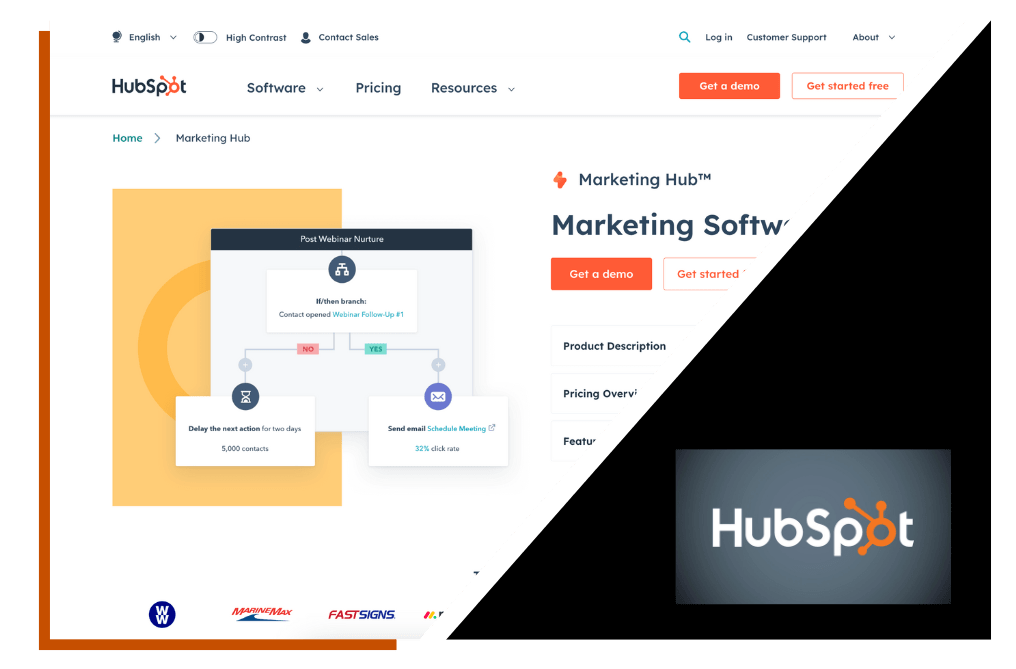
HubSpot is much more than an email Marketing tool. In fact, they have developed quite complex software for all things CRM. The email marketing features offered by HubSpot are similar to numbers 1 and 2 on this list; however, where HubSpot is unique is its all-in-one CRM solution approach. Essentially it's like buying into an ecosystem where each tool (email marketing, website, CRM, etc.) is all running on the same system.
Key Features
- Industry-best email marketing features and customizability.
- Great for growing companies needing an all-in-one solution.
- Wide variety of features for small businesses.
4. MailerLite
MailerLite is an easy-to-use email marketing tool – especially for beginners – but where it really excels is at selling subscriptions. Users can choose from three campaign styles, then personalize the messaging for different target customers to get the most out of your email effort. Much of the workflow is automated, and one of the best features is its free version.
If your email list is 1,000 subscribers or less, you can design your own custom email campaign and send as many emails as you want, making it great for smaller businesses or digital creators with a subscription model. Many in the growing digital economy are focused on e-learning and online classes – it's an industry projected to be worth about 645 billion by 2030 – and if that’s you, this might be a winner.
Key Features
- Targeted customization for different customer segments
- Automated workflow templates
- Free version for 1,000 subscribers or less
Email Marketing Serves One Purpose.
Email marketing is still an important part of today’s digital landscape, even if you’re not running a massive company. And it doesn’t have to be overwhelming. With a sound email marketing strategy/platform in place, your business can realize more revenue, greater customer loyalty, and growth.
Get Started With Cause Machine
Starting with a community engagement strategy is the secret to building a successful platform in the long term. Cause Machine helps customers build the plan of engaging a community well and then begin mapping out the technology to help support that strategy. We’re certain that you’ll find some great resources and powerful tools in Cause Machine to better engage your community. Learn how it can work for you here.
Grow a Digital Community, Build Revenue
- Community
- Guiding People
- Technology
- and 1 more...

A successful community looks very different than it did years ago. Whether you’re an aspiring influencer, an artist, an entrepreneur or you run a non-profit, today’s success is often made online – and almost always goes hand in hand with a thriving digital community.
Why Start a Digital Community?
Just like building a community in the real world, a digital community is just a group of people with a shared identity. But this group is different. In a digital community, members can easily join or leave the group, meaning they only stay with the ones they like. It’s not as simple as being born into a neighborhood, and forever being part of that group.
Digital communities are created by people with a shared goal or interest, who take that commonality and make it the center of a whole online ecosystem. They interact, build friendships, debate, celebrate, support and even shop, all while keeping the common core in mind. These digital communities are vital to modern businesses and organizations and should be skillfully cultivated.
A Digital Community Can Mean More Revenue
A thriving digital community can drive sales, strengthen name recognition and get people involved with a cause – but those people are more than just customers or fans. When healthy, members act almost like ambassadors, carrying a message out into the world, and helping brands achieve goals and grow bigger.
It involves capturing attention and earning respect and trust. Communities can do this by making self-expression feel safe and making it worth while for community members to get involved. That involvement should be something that signals passion – making a purchase, signing up for a volunteer opportunity, or even just sharing a post with the group. Hopefully, it will create enough goodwill and loyalty to keep the community members engaged over and over.
Ultimately, all modern brands and missions need a digital community, but if creating one sounds scary, don’t worry. It’s not nearly as daunting as it seems. It should be noted that the most effective examples are not always the ones with the most followers – they’re the ones whose members feel most comfortable engaging.
3 Steps to Building a Successful Digital Community
1. Know Your Role
First things first, and you need to get real about what you want from this digital community. Consider why you are starting it, the needs of the brand, and who you are serving. That last one is a biggie – you have to have an ideal member in mind and prepare your messaging for them. What do they like? What are they against? Only by knowing your users can you find something in common with them, which is your core community bond.
- Imagine your ideal member, and try to be as realistic as possible.
- Find something in common, and be prepared to highlight that.
- This will begin to generate a shared identity.
2. Give Ownership to Members
Here’s a secret: Just because you built the community, that doesn’t mean it’s yours. A true digital community belongs to the people, and people value a community most when they connect, engage, and feel encouraged to share. Whether in an open forum, live event, or even a digital community around learning through online courses. Always listen to the community members and consider their suggestions; this will give them a sense of ownership. And when you do start sharing content, be human, and be vulnerable in what you express (this isn’t the place for corporate business-speak).
- Listen to your community and give members a sense of ownership.
- Focus on solutions (not problems), and be human (not HR).
- Offer something of value.
3. Share the Wins
This may come as a surprise, but there is evidence that a digital community is at its most active when celebrating success, even if it’s a small win. According to a study by The Visual Capitalist shared by Rolling Stone’s Culture Council, even the world’s biggest influencers see peaks in interaction when they announce milestones like new albums, endorsements, or personal achievements – you can do this, too. Is a longtime team member getting married? Have you reached a sales goal or some other marker of progress? Share it with your community, because they just won, too. That’s the point of community to begin with. In the immortal words of Billy Dee Williams, “Success is nothing without someone you love to share it with.”
- Share your goals and achievements.
- Celebrate them like family.
- Ride the wave with follow-up posts.
Get Started With Cause Machine
Starting with a community engagement strategy is the secret to building a successful platform in the long term. Cause Machine helps customers build the plan of engaging a community well and then begin mapping out the technology to help support that strategy. We’re certain that you’ll find some great resources and powerful tools in Cause Machine to better engage your community. Learn how it can work for you here.
Seven Types of Innovation

There are countless types of innovations you could facilitate - each with their own strategy, design, timeframe, and more. The important thing to know is that each type of problem you’re working to solve has a unique run of play for how that innovation should be facilitated. My goal here is to unpack seven core types of innovations to consider. It’s important that you help your client understand which innovation they are desiring before launching the event.
#1 Concept Sketch
Overview: A Concept Sketch Innovation is when there is a felt need and/or a basic idea with a very open minded or open-handed approach to how that might come to life.
Goal: The outcome from this innovation would be a fresh idea, in concept format, for how to approach this problem.
#2 Framework Design
Overview: A Framework Design Innovation is when there is a defined project/goal but there is a needed framework or picture needed to help simply capture the overall complexity.
Goal: The outcome from this innovation would be sketches of this framework (picture, pathway, etc.)
#3 Vetting Concept
Overview: A Vetting Concept Innovation is when there is a plan in motion and a fairly good picture of the desired goal, but a desire to “vet” out the concept more and gain more collaborative buy-in.
Goal: The outcome from this innovation would be more details to the plan, a stronger prototype of the concept, and greater unity around the vision.
#4 Business Plan
Overview: A Business Plan Innovation is when there’s an agreed upon plan already existing, but there is lacking a more comprehensive business plan with specific details for execution
Goal: The outcome from this innovation would be a multi-page business plan outlining specific Go to Market strategies.
#5 Resource Design
Overview: A Resource Design Innovation is when there is a need to design (or potentially redesign) a resource - focusing on the resource design, purpose, and delivery.
Goal: The outcome from this innovation would be the prototyping of fresh resources with some content creation and strategy.
#6 Process Design
Overview: A Process Design Innovation is when there is a new process (or a process to re-vision) and a need to collaboratively streamline and make a process.
Goal: The outcome from this innovation would be a process design map with detailed steps, dependencies, and outcomes.
#7 Rethink
Overview: A Rethink Innovation is when there is a pre-existing program that could use some fresh thought and fresh ideas.
Goal: The outcome from this innovation would be a new concept plan for how to approach this in a more current context.
As you can see, there are many types of innovations you could facilitate. More than likely, just seeing the list sparked a few ideas for innovations you might consider.
Cause Machine Solutions
Here at Cause Machine, we help organizations solve complex community engagement problems/questions. We use these disciplines of innovation ourselves in our own development process and have helped lead many organizations through their own process of innovation discovery. Leveraging the Cause Machine platform for engaging your community helps you be confident that the foundations of this platform are built on time-tested best practices of great processes like innovation and design thinking. Schedule a demo today!
Master Alumni Engagement Best Practices
- Community
- Content Strategy
- Guiding People
- and 4 more...

For any university, college, or school system, alumni networks are important. A network of alums doesn’t just help meet fundraising goals, but members can even act as public ambassadors, mentor students and offer post-graduation job opportunities, support athletic departments, and even help increase new student enrollment.
But the key to all that is good alumni engagement, and not everyone does it well. Today we’ll explore some alumni engagement best practices to make your network as strong as it can be.
How Important is Alumni Engagement?
According to a 2020 report by the Council for Advancement and Support of Education, alumni giving at U.S. colleges totaled more than $11 billion in 2019. That’s a lot of money, but it’s not spread out evenly.
Only 8 percent of U.S. alumni give to their alma mater on average, according to that same survey of 1,451 ranked colleges. Meanwhile, the top schools in the study were seeing giving rates of 44 percent and higher. Once again, the difference is a strategic approach to alumni engagement.
Donor Search notes that a full 93 percent of alumni associations “offer no direct benefits to their members.” Let’s make sure you don’t fall into that category.
6 Alumni Engagement Best Practices
1. Know Your Audience
As with any community nurturing operation, the first step is to know who you are talking to. Your alumni network is mostly likely diverse, so create a few categories and different messaging for each category of alums. Make sure to keep your member database (CRM) up to date, too – there’s no point in reaching out to people who have dropped off the rolls.
- Update your database constantly.
- Make sure you have a system for getting 'new' alums involved.
- Segment your target members into categories.
2. Tailor Content to Your Alums
Now that you have some categories set up, it’s important to create messaging that speaks to each one directly. If you’re talking to fans of the school’s sports programs, keep that in mind. Graduates from an Education program? People with a Finance degree? Take a different approach with each different group of people. Not everyone will want to engage with the school. But lifelong fans are ready to jump in and support/engage how they can.
- Find out what content (videos, news, articles, podcasts, etc.) your alums will find valuable (test if you're not sure).
- Create a distinct customer journey alumni will work through, then insert relative 'asks' along the way.
3. Don’t Just Ask for Money
Fundraising is a big part of why the network exists, but when it comes to alumni engagement best practices, you can’t just solicit donations and nothing else. Members will start to delete or ignore the content reflexively. Instead, send them news on new programs and sports updates, offer perks from local partner businesses, and anything that will make them feel like they're still part of the community. Free guides, offers, and perks are always good choices.
- Add in non-fundraising communication.
- Include local news, program updates, and sports results are all good ideas.
- Offer alumni discounts from partner businesses.
4. Mix Things Up
People get bored easily, and if you’re only reaching out via one mode of communication, it will get old fast. Plan out a healthy mix of email campaigns, articles, video content, podcasts, snail mail, and even texting. Also, use video and social media to reconnect with old alums – especially alumni-generated content, which sees a high rate of engagement. Alumni photos from the big game? Student snaps of their favorite part of campus? That’s all great.
- Utilize different modes of communication.
- Vary between email, newsletters, alternate platforms, etc.
- Highlight user-generated content whenever possible.
5. Keep It Steady
High on the list of alumni engagement best practices is regular communication. Plan out ways to be consistent in reaching out, even as you mix up the mode of contact and message. It shows you are engaged and that effort will be appreciated. It will also keep your school fresh in the alumni’s memory.
- Set up an editorial calendar to track content production and publishing.
- Look to start monthly email nurture campaigns, quarterly newsletters, regular events, and reunions.
6. Deliver a Sense of Ownership
Finally, the most engaging alumni networks have one thing in common: They make their members feel a sense of ownership in the institution. They probably already feel a sense of pride in the school, so you just have to take that one step further. Creativity is welcome here, but it could be done with something as simple as a survey. Take the results, listen to the members, and keep them in mind when making changes, planning events, or expanding. Then report back through your network.
- Remind alums that they (and their honest opinion) are valued.
- Create surveys and act on feedback.
- Build your site on a reliable membership platform that offers features to help engage alums.
To Succeed, You Need a Strategic Plan to Manage Alumni
As we’ve seen, engagement is the most important factor in a high-functioning alumni network, and the returns on your hard work can be game-changing. These alumni engagement best practices aren’t complicated, and most of them aren’t even hard to do, but they will help you give the most to your members and get the most for your institution.
Get Started With Cause Machine
Starting with a community engagement strategy is the secret to building a successful platform in the long term. Cause Machine helps customers build the plan of engaging a community well and then begin mapping out the technology to help support that strategy. We’re certain that you’ll find some great resources and powerful tools in Cause Machine to better engage your community. Learn how it can work for you here.
5 Best Association Management Software Platforms
- Community
- Marketing
- Technology
- and 1 more...

The vast majority of associations are run by fewer than ten people – small teams who already rely on, or could benefit from, association management software. The truth is that each one of those associations requires a lot of hands-on administration, even if it's small. That administration is expensive and time-consuming and is basically a time suck for the few employees a small association has.
Despite that, it's still vital work – and association management software aims to help.
What Makes Association Management Software Different from Other Software?
A quality association management software platform can do everything from building a website to running a member database. They can automate email communications, payment collections, donations, event management, and make sure all the financial requirements of running an association are met. In short, they can free your team up to do the things that associations are really meant to do.
The problem lies in choosing the right association management software for your association, but we can help. Culled from hundreds of association management software options, here are five of the best.
The Five Best Association Management Software Platforms Right Now
1. Cause Machine
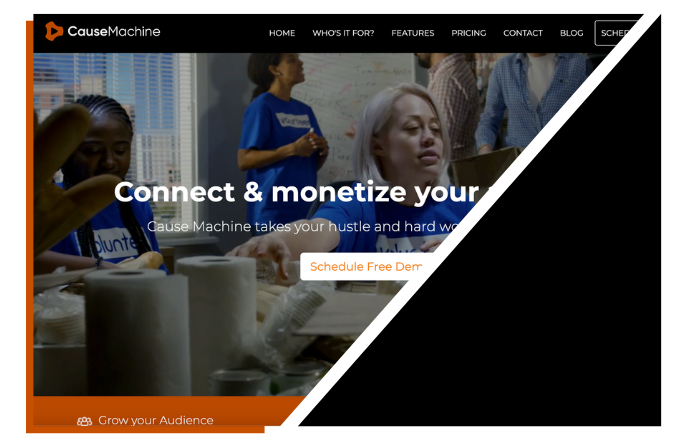
Up until now, we've introduced association management software options that are useful in a variety of situations – but Cause Machine is something different. The most versatile option by far, Cause Machine is an infinitely customizable platform that can meet all the needs of an association – large, small, or in between.
Building a cost-effective and practical web platform to manage your association is key for scalability and experience. You can even create members-only areas with added benefits too. Cause Machine can supercharge communications, help maintain the day-to-day, and even streamline association events. Cause Machine starts by defining your objectives and helps you build the platform to meet your organizational needs.
Great features include:
- Tailored software for specific association needs
- Drag and drop web builder
- Free trial and dedicated support
- Event management
- Email marketing tools
- eCommerce, membership billing, managed tiers, and more
- Dynamic CMS
- Job Board
- Launch Mobile Apps
- Free trial available
Especially for the thousands of small associations that need a practical association management tool, getting off the treadmill of hands-on administration is as easy as trying out the right association management software.
Get a tailored solution to your organization's needs. Schedule a free demo with Cause Machine to get back to doing what your association is really meant to do.
2. WildApricot
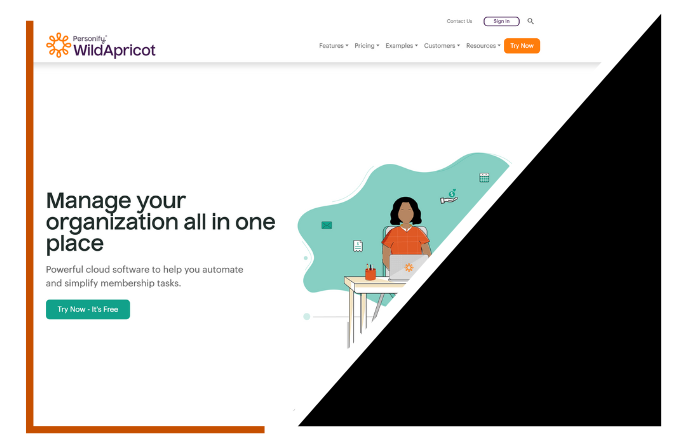
\WildApricot has steadily become one of the most visible association management software platforms, and that's because it comes with many of the features associations need. From a (basic) website builder to a built-in email system and a mobile app, it can be helpful to organizations of all sizes – and comes with a free trial period.
Great features include:
- Build websites and member directories
- Event Management
- Automate payments and renewals
- Free 60-day trial
3. GrowthZone
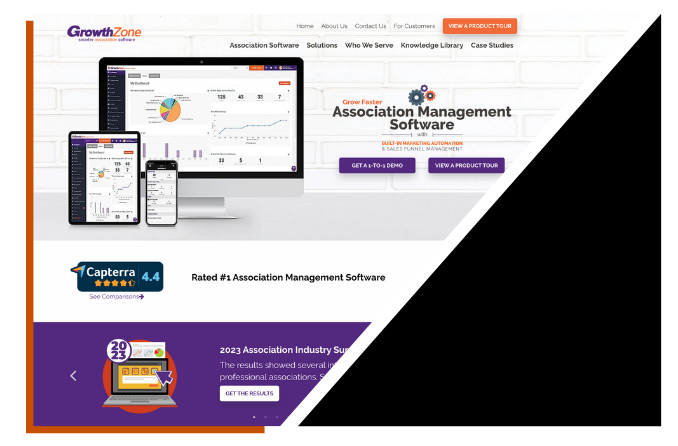
GrowthZone is an association management software option that is focused on what its name implies – growth! The basic plan includes everything that others do as well – including member management tools, financial tools, and the like – but it can be scaled up with marketing solutions and added "modules" as your organization grows, which is ultimately the whole point, right?
Great features include:
- Website builder with member and event management tools
- Marketing tools and sales funnel
- Payment processing
- Free demos and monthly payment plans
4. MemberLeap
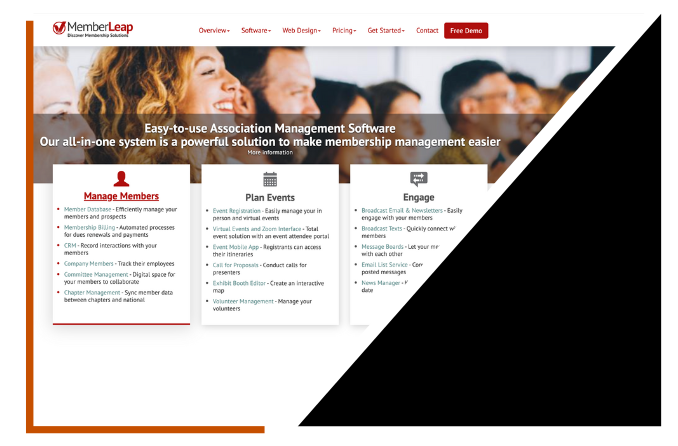
MemberLeap is an example of powerful association management software that is tailored for one specific segment of the association landscape. Along with all the basic functions of member and financial management, it features a convenient integration with QuickBooks. With 26.5 million businesses using QuickBooks in the US, that could be very useful!
Great features include:
- Member database with plans
- Integrates with QuickBooks for accounting
- CRM system
- Starts at $50/month, plus website setup packages from $1,800+
5.SilkStart
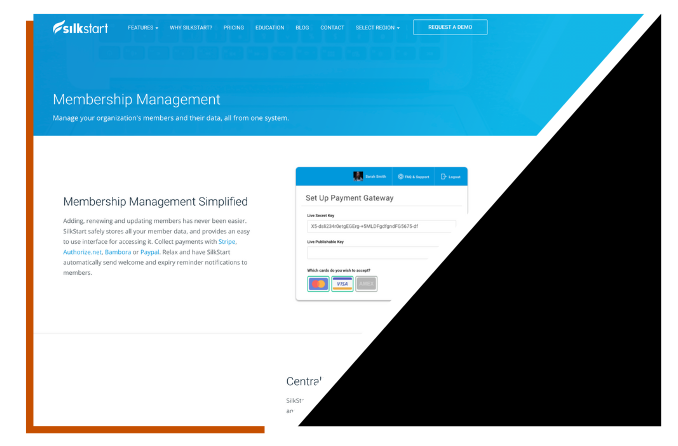
With SilkStart, small associations can get everything they need – and the "smooth" transition they hope for. This software is designed to be simple and easy to use for administrators, and its features are designed to get the job done. Features include job boards, donation pages, chapter integration, and mobile-friendly websites.
Great features include:
- Simple tools for website, members-boards, donations, and more
- Event management
- Job board
- Email Marketing
Get Started With Cause Machine
Starting with a community engagement strategy is the secret to building a successful organization in the long term. Cause Machine helps organizations build the plan of engaging a community well and then begin mapping out the technology to help support that strategy. We're certain that you'll find some great resources and powerful tools in Cause Machine to better engage your community. Learn how it can work for you here.

